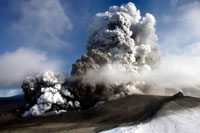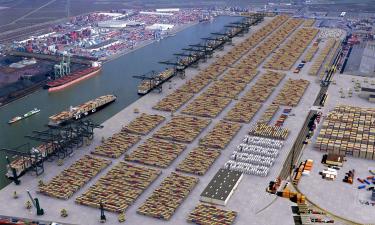Awakened Monster with Unpronounceable Name is Not Going To Fall Asleep Soon
A cloud of volcanic ash that has reached the Russian capital caused panic among residents. The promise of acid rains that followed has ruffled Muscovites. Pert Fyodorov, a scientist with Geology Department of Saint Petersburg State University told Pravda.ru that the ashes may harm people’s health, but acid precipitations does not pose any threats.

“There are various types of volcanoes. Let’s remember the story of Pompeii, for instance, where the entire city was buried under streams of lava. But Icelandic volcanoes are unique, and their eruptions are completely different,” Fyodorov explained.
“These volcanoes are dry, because ashes ejections are dehydrated to 0.5% unlike, for instance, Indonesia volcanoes with the level of humidity at 8%. Since dry volcanoes emit small amount of haloid acids (HCl; HBr), chances of acid rains after the eruption are very slim. However, ejected ashes may form a “hot cloud” which is a mixture of ashes, gas and water steam that transform into a heavy vapor suspended matter and blanket flatlands.
Another negative factor that may affect not only Iceland is the so-called ashfall that may cover expansive territories. Forecasters expect that the ashes may spread not only to the European part of Russia including Moscow and Saint Petersburg, but even further.
Additionally, ash particles in the air interfere with the sun rays, which may negatively affect future harvest and impede growth of plants. On the other hand, volcanic ash is a wonderful fertilizer.
Obviously, volcanic ash is harmful for human health, especially for the people suffering from asthma and other respiratory diseases. In particular, Europeans are not recommended to leave their houses if not necessary,” Fyodorov said.
Other specialists assure Russians that dust in the streets is not necessarily a product of a remote volcano. “Large ashes that can be noticed from a distance quickly land on the ground. There is no way they would get as far as Moscow,” Tatyana Pozdnyakova, a leading specialist of Moscow Weather Agency told Komsomolskaya Pravda. “Only fine fractions can reach us. Most of the time they are not even visible. When they are visible in large concentrations, they look like haze.”
“We have enough of our own dust carried by wind. April was abnormally dry and Moscow has not gotten rid of winter dirt yet because rains did not clear the air and ground. The clouds over Moscow are not volcanic but regular cumulus. Air vortexes may form under such clouds and look impressive, but it is a normal spring process,” she added.
Yet, she believes that the Iceland volcano might have affected current Moscow weather. “The amount of nucleation in the atmosphere formed by the finest ash particles might have increased. Moisture accumulates around nucleation, drops fall on the ground, and it rains. It is not ruled out that if it was not for the volcanic cloud, there would be no rain. Yet, it is hard to tell for sure, we would have to conduct analysis of chemical and physical processes in the clouds,” she said.
Arkady Tishkov, deputy director of the Institute of Geography thinks that clouds of ashes formed after the eruption may affect the climate, Interfax reports.
“There may be local acid rains, but it happens in Moscow. Plus, colder weather is possible, and respectively, average temperatures may become lower,” Tishkov clarified.
He thinks that the eruption was of local nature despite the fact it has been going on for three days. “The cloud spread to densely populated regions of Europe, which is why the acting volcano attracted so much attention. We had even stronger eruptions in Kamchatka region but there was not much discussion about it because the clouds of ashes were spewed over under-populated territories or in the ocean,” the scientist said.
According to the information provided by Russia’s Hydrometeorology and Environmental Monitoring Agency, “the cloud of volcanic ashes is spreading and on Friday, at 10pm Moscow time, it will be located in the air of north-western areas of Russia – Kaliningrad and Saint Petersburg, as well as upper Volga areas (Nizhny Novgorod). It is also mentioned that “according to the forecast, dust cloud is spreading over the Russian territory from the Arctic latitude between 40 and 50 degrees of East longitude and will reach 50 degrees of north latitude, which is South of Moscow.”
"The ashes in the cloud pose no threat to the population in the existing concentration,” specialists emphasize. It is worth mentioning that the Ministry of Nature carefully observes the situation. "I can honestly say that it is difficult to control the spreading of the cloud, at least, for Hydrometeorology and Environmental Monitoring Agency. We will monitor the situation on the ground,” Yuri Trutnev, head of the Ministry, assured.
Ekaterina Lastochkina
Vyacheslav Lokatsky
Pravda.Ru
Subscribe to Pravda.Ru Telegram channel, Facebook, RSS!



